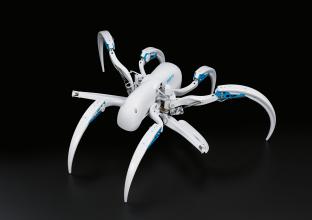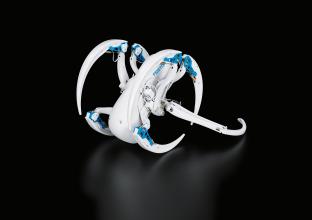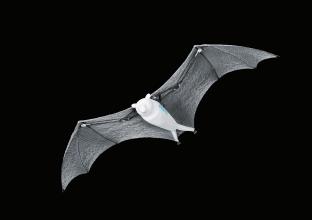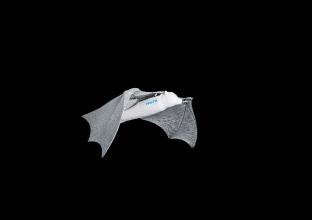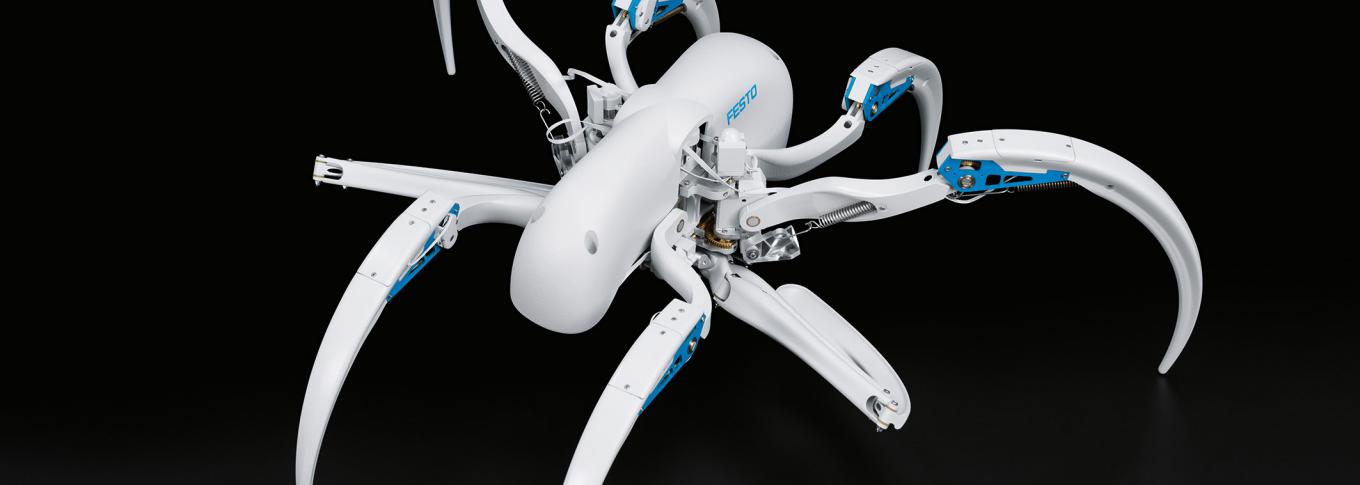
Unique forms of motion derived from nature
Walking and rolling like the flic-flac spider – the BionicWheelBot moves along the ground in astounding ways. Together with the team headed by the discoverer of the spider, Professor Ingo Rechenberg, Festo has taken a very close look at these unique forms of locomotion and has technically realised them. But no magnifying glass was needed for the flying fox: the BionicFlyingFox is an imposing figure with its wingspan of 2.28 metres and its partly autonomous aerobatics, which are made possible by a motion tracking system and machine learning.
The biological model for the BionicWheelBot is the flic-flac spider (Cebrennus rechenbergi), which lives in the Erg Chebbi desert on the edge of the Sahara. Professor Ingo Rechenberg, a bionics professor at the TU Berlin, discovered it there in 2008. The flic-flac spider can walk like other spiders; however, it can also move with a combination of somersaulting and rolling on the ground. It is therefore ideally adapted to its surroundings: on even ground, it is twice as fast in so-called rolling mode than when walking.
Since the spider’s discovery, Professor Rechenberg has been working on transferring its movement patterns to technological applications. On the basis of these extensive studies, Rechenberg and his team first constructed a number of prototypes for the BionicWheelBot. He has now further developed the kinematics and drive concept of the artificial spider together with Festo as part of the Bionic Learning Network.
The BionicWheelBot: transition from walking to rolling mode
Just like a natural spider, the BionicWheelBot propels itself with a tripod gait, whereby it uses six of its eight legs to walk. In order to start rolling, the BionicWheelBot bends three legs on each side of its body to make a wheel. The two legs that are folded up during walking are then extended, push the rolled-up spider off the ground, and continuously push it forward whilst rolling. This prevents the BionicWheelBot from grinding to a halt and ensures that it can keep moving forward even on rough terrain.
In rolling mode, the BionicWheelBot performs a somersault with its whole body, just like the real flic-flac spider. Thanks to its integrated inertial sensor, it always knows what position it is in and when it has to push off again. It, too, is therefore much faster when rolling than walking, and it can even overcome uphill inclines of up to five per cent.
BionicFlyingFox – ideal flight path thanks to machine learning
To emulate the natural flying fox as closely as possible, the wing kinematics of the BionicFlyingFox are also divided into primaries and secondaries; all the joints lie in the same plane. The wings are covered with an elastic membrane, which extends down to the feet. This flying membrane is wafer-thin and ultralight, but also robust.
Motion tracking system for semi-autonomous flight
To enable the BionicFlyingFox to move semi-autonomously within a defined space, it communicates with a so-called motion tracking system. The installation with two infrared cameras constantly records its position. The cameras, which are mounted to a pan-tilt unit, can be rotated and inclined in such a way as to track the entire flight of the BionicFlyingFox from the ground. At the same time, the motion tracking system plans the flight paths and issues the required control commands. Starting and landing are performed by the human operator; the autopilot takes over in flight.
Machine learning for the ideal flight path
The images from the cameras are conveyed to a central master computer, which evaluates the data and externally coordinates the flight like an air traffic controller. Pre-programmed flight routes stored on the computer specify the path taken by the BionicFlyingFox in performing its manoeuvres. The wing movements required to ideally implement the intended movement sequences are calculated by the artificial flying fox itself with the help of its on-board electronics and its complex behaviour patterns. The flying fox receives the necessary control algorithms from the master computer, where they are automatically learnt and constantly improved. The BionicFlyingFox is thus able to optimise its behaviour during flight and thereby follow the specified courses more precisely with each circuit flown.
Innovative flying membrane for various different applications
The innovative flying membrane was specially developed by the bionics team for the BionicFlyingFox. It consists of two airtight foils and a woven elastane fabric, which are welded together at approximately 45,000 points. The fabric’s honeycomb structure prevents small cracks in the flying membrane from increasing in size. The BionicFlyingFox can thus continue flying even if the fabric sustains minor damage. Due to its elasticity, the flying membrane stays almost uncreased even when the wings are retracted. Since the foil is not only elastic, but also airtight and lightweight, it could also potentially be used in other flying objects or for clothing design and in the field of architecture.
The Bionic Learning Network
Over ten years ago Festo initiated the Bionic Learning Network, which is closely linked with the processes of innovation within the company. In cooperation with students, renowned universities, institutes and development companies, Festo sponsors projects, testbeds and technology platforms. The objective is to benefit from bionics as a source of inspiration for new technologies and to realise these in industrial automation.
Festo is a global player and an independent family-owned company with headquarters in Esslingen am Neckar, Germany. Festo has set standards in industrial automation technology and technical education ever since its establishment, thereby making a contribution to sustainable development of the environment, the economy and society. The company supplies pneumatic and electrical automation technology to 300,000 customers of factory and process automation in over 35 industries. Digitalization, AI and the LifeTech sector with medical technology and laboratory automation are becoming increasingly important. The products and services are available in 176 countries. With about 20,600 employees in over 250 branch offices in around 60 countries worldwide, Festo achieved a turnover of around €3.45 billion in 2024. More than 8% of this turnover is invested in research and development. In this learning company, 1.5 % of turnover is invested in basic and further training. Festo Didactic SE is a leading provider of technical education and training and offers its customers worldwide comprehensive digital and physical learning solutions in the industrial environment.

